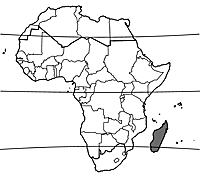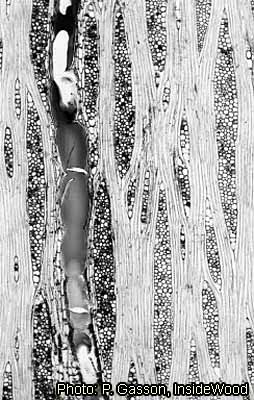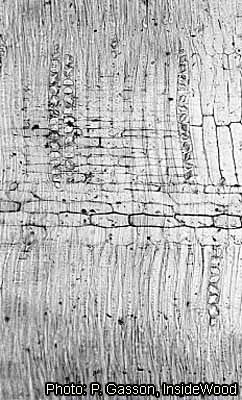Brandzeia filicifolia (PROTA)
Introduction |
Brandzeia filicifolia Baill.
- Protologue: Adansonia 9: 217 (1869).
- Family: Caesalpiniaceae (Leguminosae - Caesalpinioideae)
Synonyms
- Bathiaea rubriflora Drake (1903).
Origin and geographic distribution
Brandzeia filicifolia is endemic to northern and western Madagascar, where it occurs from Antsiranana south to Morondava.
Uses
The wood is used for planks in house construction.
Properties
The wood is whitish and hard.
Description
- Deciduous small to medium-sized tree up to 25 m tall; bole up to 60 cm and sometimes more in diameter; bark surface smooth and pale grey, with numerous lenticels, inner bark thick, fibrous, reddish; twigs slightly fleshy, glabrous, silvery grey-brown, with numerous lenticels.
- Leaves alternate, pinnately compound with (5–)7–9 leaflets; stipules triangular, small; petiole 1–3 cm long, rachis slightly zigzag, 4.5–10 cm long; petiolules 3–4 mm long; leaflets alternate, elliptical to ovate or oblong, 3.5–7(–8) cm × 1.5–3.5(–4) cm, slightly unequal, glabrous, pinnately veined.
- Inflorescence a panicle, often many together into dense and complex clusters, branches up to 3.5 cm long, many-flowered.
- Flowers bisexual, regular, bright pink-red, sessile; hypanthium obconical, 7–9 mm long, resembling a pedicel; sepals 4, free, broadly triangular-elliptical, 3.5–4 mm long, concave, with many large gland dots; petals 5, free, oblong-elliptical, 6.5–7 mm long, clawed at base; stamens 10, free, 13–20 mm long; disk prominent, grooved, yellow-green; ovary superior, 2–2.5 mm long, with stipe c. 3 mm long, glabrous, style slender, c. 11 mm long.
- Fruit a samara-like pod 7–8 cm long, with 5–8 mm long stipe, glabrous, pale brown, with a single apical seed and a large basal wing, with ridge over the seed-containing portion, indehiscent, with persistent sepals at base.
- Seed oblong-ovate, flat, 1.5–2 cm long, reticulately veined, blackish brown.
Other botanical information
Trees flower when they are leafless and they are then very conspicuous because of the profusion of flowers. It has been observed that the flowers are visited by small sunbirds, which may play a role in pollination. New leaves usually start developing when the fruits have ripened. The fruits, which strongly resemble those of maples (Acer) except that the seed is at the apex and the wing at the base, are dispersed by wind; the wing makes that the fruit spins rapidly and falls slowly.
Brandzeia comprises a single species. Its affinity is still uncertain, but Neoapaloxylon, a genus of 3 species occurring in dry regions of western and southern Madagascar, has similar fruits. Neoapaloxylon differs in leaflets and sepals having small red-brown glandular dots, the absence of petals and the absence of a ridge over the seed-containing portion of the fruit.
Ecology
Brandzeia filicifolia occurs in deciduous woodland, up to 300 m altitude. It is often found on limestone soils, but has also been recorded from sandy, basalt and gneiss soils.
Management
Fruits can be collected from the ground in November–December; they should be sown as soon as possible.
Genetic resources
Although Brandzeia filicifolia is fairly widely distributed in Madagascar, it seems to be common only locally, especially in the limestone massifs of Ankarana and Namoroka.
Prospects
Very little is known about Brandzeia filicifolia, of which the bole becomes large enough to be interesting for the production of wood that has apparently a fair quality. Research is needed on nearly all aspects before its prospects can be judged. However, it is probably not common enough to promote increased usage.
Major references
- du Puy, D.J., Labat, J.N., Rabevohitra, R., Villiers, J.-F., Bosser, J. & Moat, J., 2002. The Leguminosae of Madagascar. Royal Botanic Gardens, Kew, Richmond, United Kingdom. 750 pp.
- Schatz, G.E., 2001. Generic tree flora of Madagascar. Royal Botanic Gardens, Kew, Richmond, United Kingdom. 477 pp.
Other references
- Lewis, G., Schrire, B., MacKinder, B. & Lock, M., 2005. Legumes of the world. Royal Botanic Gardens, Kew, Richmond, United Kingdom. 577 pp.
- Randrianasolo, J., Rakotovao, P., Deleporte, P., Rarivoson, C., Sorg, J.-P. & Rohner, U., 1996. Local tree species in the tree nursery. In: Ganzhorn, J.U. & Sorg, J.P. (Editors). Ecology and economy of a tropical dry forest in Madagascar. Primate Report 46–1. German Primate Center, Göttingen, Germany. pp. 117–132.
Author(s)
- R.H.M.J. Lemmens, PROTA Network Office Europe, Wageningen University, P.O. Box 341, 6700 AH Wageningen, Netherlands
Correct citation of this article
Lemmens, R.H.M.J., 2010. Brandzeia filicifolia Baill. [Internet] Record from PROTA4U. Lemmens, R.H.M.J., Louppe, D. & Oteng-Amoako, A.A. (Editors). PROTA (Plant Resources of Tropical Africa / Ressources végétales de l’Afrique tropicale), Wageningen, Netherlands. <http://www.prota4u.org/search.asp>.
Accessed 17 December 2024.
- See the Prota4U database.




